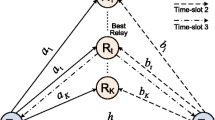Abstract
We constructed a single-relay-station cooperative communications system, featuring integration between the dynamic decode-and-forward (DDF) protocol and network coding (NC) to examine the outage probabilities in the Rayleigh, Rician, and Nakagami fading channels. In addition, the diversity-multiplexing tradeoff of the system was analyzed to examine improvements for system performance through integrating these two technologies. Through simulations and analyses, we discovered that the systems featuring NC had lower outage probability and greater diversity gain, and consequently, greater system reliability compared to the ordinary system featuring only the DDF protocol. However, because we added a final phase for the transmission of network coded signals, the system showed lower multiplexing gain compared to the system featuring only the DDF. Users should adopt this system based on their needs. For example, in situations that have higher requirements for reliability and lower requirements for multiplexing gain, users can adopt a DDF-NC cooperative communications system.




















Similar content being viewed by others
References
Ahlswede, R., Cai, N., Li, S. Y. R., & Yeung, R. W. (2000). Network information flow. IEEE Transactions on Information Theory, 46(4), 1204–1216.
Azarian, K., Gamal, H. E., & Schniter, P. (2005). On the achievable diversity-multiplexing tradeoff in half-duplex cooperative channels. IEEE Transactions on Information Theory, 51(12), 4152–4172.
Beniero, T., Redana, S., Hamalainen, J., & Raaf, B. (2009). Effect of relaying on coverage in 3GPP LTE-advanced. In IEEE 69th vehicular technology conference, pp. 1–5. Barcelona, Spain, doi:10.1109/VETECS.2009.5073520.
Holter, B., & Oien, G. (2005). On the amount of fading in MIMO diversity systems. IEEE Transactions on Wireless Communications, 4(5), 2498–2507. doi:10.1109/TWC.2005.853832.
IEEE 802.16 Task Group m (TGm): IEEE standard for local and metropolitan area networks part 16: Air interface for broadband wireless access systems amendment 3: Advanced air interface. IEEE Std 802.16m-2011 (Amendment to IEEE Std 802.16-2009) pp. 1–1112 (2011). doi:10.1109/IEEESTD.2011.5765736.
Laneman, J. N., Tse, D. N. C., & Wornell, G. W. (2004). Cooperative diversity in wireless networks: efficient protocols and outage behavior. IEEE Transactions on Information Theory, 50(12), 3062–3080.
Peters, S., & Heath, R. (2009). The future of WiMAX: Multihop relaying with IEEE 802.16j. IEEE Communications Magazine, 47(1), 104–111. doi:10.1109/MCOM.2009.4752686.
Sendonaris, A., Erkip, E., & Aazhang, B. (2003). User cooperation diversity—part I. System description. IEEE Transactions on Communications, 51(11), 1927–1938.
Sendonaris, A., Erkip, E., & Aazhang, B. (2003). User cooperation diversity—part II. Implementation aspects and performance analysis. IEEE Transactions on Communications, 51(11), 1939–1948.
Wang, L. C., Liu, W. C., & Wu, S. H. (2011). Analysis of diversity-multiplexing tradeoff in a cooperative network coding system. IEEE Transactions on Communications, 59(9), 2373–2376.
Wannstrom, J. (2013). LTE-advanced http://www.3gpp.org/lte-advanced.
Wikipedia: Erlang distribution—wikipedia, the free encyclopedia (2014). http://en.wikipedia.org/wiki/Erlang_distribution.
Wikipedia: Rayleigh distribution—wikipedia, the free encyclopedia (2014). http://en.wikipedia.org/wiki/Rayleigh_distribution.
Yang, Y., Hu, H., Xu, J., & Mao, G. (2009). Relay technologies for WiMAX and LTE-advanced mobile systems. IEEE Communications Magazine, 47(10), 100–105. doi:10.1109/MCOM.2009.5273815.
Zheng, L., & Tse, D. N. C. (2003). Diversity and multiplexing: A fundamental tradeoff in multiple antenna channels. IEEE Transactions on Information Theory, 49(5), 1073–1096.
Author information
Authors and Affiliations
Corresponding author
Rights and permissions
About this article
Cite this article
Liu, WC., Shih, CH. The Performance of Systems Featuring Dynamic Decode-and-Forward and Network Coding. Wireless Pers Commun 80, 521–541 (2015). https://doi.org/10.1007/s11277-014-2024-4
Published:
Issue Date:
DOI: https://doi.org/10.1007/s11277-014-2024-4




